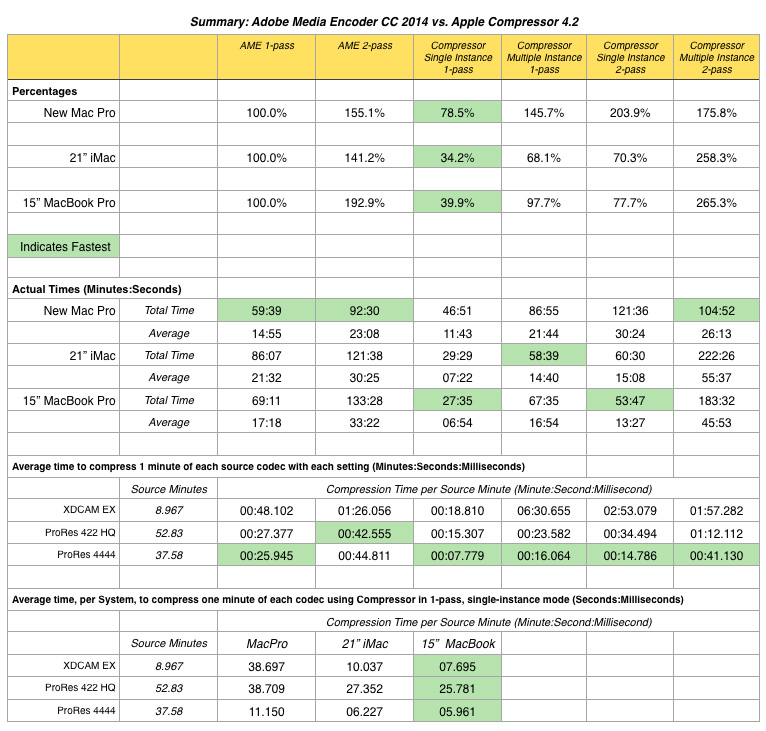 Wow! This was not what I expected.
Wow! This was not what I expected.
This week, I want to compare the compression speed of Adobe Media Encoder CC (2014) (AME) with Apple Compressor 4.2 when encoding files for YouTube using a new Mac Pro, a 21″ iMac and a 15″ MacBook Pro.
For the last year or two, AME was the hands-down speed champion. But Apple touts the new speed of Compressor, so it was time to test them both. This article is part of series looking at Apple Compressor:
EXECUTIVE SUMMARY
What’s the fastest compression software? Well, it depends…
The new Mac Pro was the fastest system for Adobe Media Encoder, while the 15″ MacBook Pro was generally the fastest system for Compressor. (And, no, I didn’t expect that!) What makes this especially interesting is that the iMac had the faster processor, while both the MacBook Pro and iMac had identical graphics cards, though the MacBook had more VRAM memory for its GPU.
The fastest setting for Compressor was 1-pass VBR. However, the default YouTube setting for Compressor is 2-pass VBR, which more than doubles compression time.
AME defaults to 1-pass VBR encoding, but that generated excessively large files. Excluding that one setting, file sizes for all different compression methods were with 5% of each other. If you are compressing with AME, be sure to use 2-pass encoding, which, also, is not the default setting.
Different codecs compress at different speeds. For example, the MacPro really struggled with XDCAM EX, while the iMac and MacBook Pro breezed through it.
2-pass compression roughly doubled compression time; however, for AME this is a good choice to reduce compressed file sizes.
Running multiple instances of Compressor only boosted the speed of the Mac Pro. For both the iMac and MacBook Pro, running multiple instances slowed performance 300 – 400%.
NOTE: This test used the same YouTube compression setting for all systems and all tests. While this does not yield the smallest file sizes, a 10 mbps bit rate will yield excellent image quality in all cases. So, no quality determinations were made.
Click here to download a PDF of all my findings so you can check my math.
TEST SYSTEMS
Late 2013 Mac Pro
Yosemite 10.10.3
3.0 GHz, 8-core Xeon processor
32 GB RAM
AMD D700 GPU
Late 2013 21″ iMac
Yosemite 10.10.3
3.1 GHz Intel Core i7
16 GB RAM
NVIDA GeForce GT750M GPU with 1024 VRAM
Late-2013 MacBook Pro
Yosemite 10.10.3
3.1 GHz Intel Core i7
16 GB RAM
NVIDA GeForce GT750M GPU with 2048 VRAM
Clips. I tested clips using three different codecs: XDCAM EX, ProRes 422HQ and ProRes 4444. Two clips had native 720p images. The other two clips were scaled to 1280 x 720 during compression. Clip durations ranged from 4 minutes to 48 minutes.
Compression settings. AME defaults to 1-pass VBR with a 16 mbps bit rate. Compressor defaults to a 2-pass VBR with a 9765 kbps bit rate. I tested both 1-pass and 2-pass VBR, with a standardized bit rate for both applications. In all cases, I used the default YouTube 720p compression setting and only modified the bit rates to match at 10 mbps. Max and Min settings in AME were identical at 10.
Compression times were reported by the application. No other apps were running during compression. Only one setting was applied to each clip. Clips compressed individually, no two clips compressed at the same time.
Compressor was restarted when I changed the number of instances.
NOTE: I have been asked to run these tests on an older Mac Pro. I tried. But I couldn’t get Yosemite to run on my 2010 Mac Pro. I would expect old Mac Pro times to be about double the iMac compression times, because it can’t take advantage of the hardware acceleration built into Compressor, and its GPU is slower than the new Mac Pro.
PERCENTAGE ANALYSIS

Here is a summary of what I learned. Green bars indicate the fastest results in each category. Because AME has been the fastest system, I set its 1-pass VBR setting to equal 100% and compared everything else to it. Faster compression speeds will be smaller than 100.
Single-instance, 1-pass VBR compression in Compressor was the fastest option of the six tests for every system. However, this is not the default YouTube setting for Compressor. If we compare the 2-pass default settings, AME is faster for the Mac Pro, while Compressor is faster for the iMac and MacBook Pro.
What really struck me, though, was how slow multiple instances of Compressor made the application. If you are compressing multiple files at the same time, this option may make sense – I didn’t test for that. However, given the performance hit created by running multiple instances, I would be very cautious in recommending this option.
ACTUAL TIME ANALYSIS
I calculated this section by totaling compression times for all four movies compressed on each system (Total Time). For completeness, I also averaged compression times, but the results were the same.
The MacPro was the clear winner when compressing for AME. But dead last when compressing using Compressor. This is because the CPUs for the iMac and MacBook Pro provide hardware acceleration which is missing from the Mac Pro.
In fact, I was stunned to see the MacBook Pro won every Compression speed test when in single instance mode.
CODEC COMPRESSION TIME PER SETTING
I also wanted to test the impact codec (video format) had on compression speed. In this section, I show how long it takes to compress a minute of each codec using each of the six tested settings.
I wasn’t surprised that XDCAM EX (a variant of MPEG-2) took longer to compress. What DID surprise me was how much slower ProRes 422 HQ was to compress compared to ProRes 4444. In all cases but one, ProRes 4444 was the fastest codec.
CODEC BY SYSTEM
I then compared the compression speed by codec for each system. Here, I used the 1-pass single-instance compression results in Compressor to compare systems and codecs.
This dramatically illustrates the speed of the MacBook Pro and the speed differences inherent in each codec.
SUMMARY
Click here to download a 4-page PDF detailing all my findings, so you can check my math.)
This test took most of three days this week – I’m glad I did it, but it took a long time. Here’s what I learned:
BIG NOTE: Adobe is a few weeks away from releasing a new version of Adobe Media Encoder. I’ll keep these results and media on file and test to see how the speeds of the new version of AME compare to this one.
As always, I’m interested in your opinions.
2,000 Video Training Titles
Edit smarter with Larry Jordan. Available in our store.
Access over 2,000 on-demand video editing courses. Become a member of our Video Training Library today!
Subscribe to Larry's FREE weekly newsletter and
save 10%
on your first purchase.
10 Responses to Speed Test: Adobe Media Encoder vs. Apple Compressor
Just did a job where I had to compress over 70 two to three minute files to upload immediately after editing and I can attest that using multiple instances was a huge time saver. I could get four files done roughly at the same time and upload those while the MacPro went to work on the next set of files. At 2AM in the morning this was a blessing.
William:
An excellent comment. Multiple instances don’t help when compressing single files. They will help when compressing multiple files in most cases. In my testing, however, I had multiple files queued for compression, with multiple instances enabled, but Compressor still compressed them individually.
As with all things technical, different situations yield different results. I’m glad multiple instances worked for you.
Larry
Actually that’s exactly what I expected since I had single pass h.264 selected and that’s what has happened in earlier version of Compressor. However to my surprise Compressor queued up four files and did them at the same time just as if I had multi-pass selected. Te processors lit up and away it went. Perhaps the YouTube selection is still programmed in single instance mode when one-pass is selected.
er – you could NOT get Yosemite to run on you 2010 MacPro?! – I ask as I am about to try to do just that!
Apologies – did not mean to sidetrack this thread….
Stu Aull
Alaska
Stu:
More precisely, I could not create a partitioned boot drive on my MacPro. I still need it to run OS X 10.6.8, so I need it to dual boot with 10.10.3. It was the second partition that I could not create.
Larry
I’m running Yosemite 10.10.3 on a 2008 Mac Pro with no issues. Works great!
Great work Larry,
If you’d like to try something perhaps even more interesting, try comparing AME, Compressor and the free Handbrake. Every time I’ve tried, HB was MUCH faster than AME and end result was much better looking…
-Tom-
ps. really enjoyed your CL Premiere workshop!
Tom:
We are hoping to do comparison testing this week between a variety of other compression applications. I’ll write it up when we get it done.
Larry
Great stuff! Looking forward to your results.
-Tom-
Larry, thanks for this!
Also, I didn’t know about the multiple instances. I missed your article here: https://larryjordan.com/articles/compressor-4-1-a-tip-to-increase-speed/ (I had to google it).
Can’t wait for your tests with the Network Compression and the new AME.
Thanks.
-Jeff